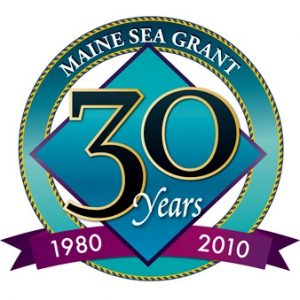Highlights from 30+ Years of Maine Sea Grant’s Work in Fisheries
 Maine Sea Grant’s relationship with the fishing industry dates to 1975, when Congress was about to pass what would become the Magnuson-Stevens Fishery Conservation and Management Act. At that time, fish harvested by Maine fishermen stayed local, only traveling perhaps as far as Boston or New York. The Gulf of Maine fishery was dominated by fleets of foreign fishing vessels, factories at sea that fished harder than anyone before. Even at Gorton’s in Gloucester, MA, 40% of the cod came from Polish boats.
Maine Sea Grant’s relationship with the fishing industry dates to 1975, when Congress was about to pass what would become the Magnuson-Stevens Fishery Conservation and Management Act. At that time, fish harvested by Maine fishermen stayed local, only traveling perhaps as far as Boston or New York. The Gulf of Maine fishery was dominated by fleets of foreign fishing vessels, factories at sea that fished harder than anyone before. Even at Gorton’s in Gloucester, MA, 40% of the cod came from Polish boats.
To understand how the new rule, which would prohibit foreign fishing fleets within 200 miles of the nation’s shoreline, would affect Maine fishermen, Jim Wilson from the Department of Economics at the University of Maine and his student research assistant Robin Alden were interviewing people about their perceptions of the impending legislation. The project was funded by Sea Grant.
“We had an industry that was nearly unregulated—nobody had experience dealing with regulators. People were being thrust into this world where the government would have a large say in how their lives ran,” said Jim Wilson. Wilson attended a meeting of fishermen in Rhode Island, and when he returned to Maine, he came up with the idea for the Maine Fishermen’s Forum. “The idea of the forum was to build a community that could start to prepare for this brave new world.”
Like other Sea Grant enterprises, the forum eventually became self-sustaining. In 1985 Sea Grant director Ron Dearborn called the forum Sea Grant’s most significant contribution to the fishing industry in New England. “Before that, fishermen didn’t think of themselves as an industry,” he said.
More highlights:
- In the 1980s, Sea Grant funded the first studies to track individual lobsters, revealing that lobsters were not sedentary, as commonly believed, but instead made long-distance migrations across the sea floor. This work was unique in its engagement of lobstermen (via Maine Lobstermen’s Association, founded in 1954).
- Sea Grant researcher Jim Wilson, seeking ways for Maine fishermen to secure higher prices and ensure a predictable supply for processors, worked with the City of Portland to develop the Portland Fish Exchange, the first display auction in North America, which opened in May 1986. Today, the Portland Fish Exchange controls over 90 percent of Maine’s groundfish market and roughly 20 percent of New England’s total annual catch.
- Sea Grant funded Bob Steneck to look at nursery habitat for American lobsters, which produced an effective method to sample young lobsters underwater, prompting subsequent grants to Rick Wahle at the Bigelow Laboratory for Ocean Sciences that helped in the creation of the quantitative Lobster Settlement Index in 1989. The index has since expanded to over 60 sites and is one of the indicators of the health of the lobster resource used by federal stock assessment scientists.
- In 1987, University of Maine System Board of Trustees voted to create the Lobster Institute, supported by Sea Grant and founded by Maine Lobstermen’s Association, Maine Lobster Pound Association, and Maine Import Export Lobster Dealers Association.
- Sea Grant supported Diane Cowan as she developed a method for surveying abundance of juvenile lobsters and discovered areas of the lower intertidal zone that serve as lobster nursery grounds. Cowan’s organization, The Lobster Conservancy, now coordinates lobster monitoring at 15 sites by over 100 volunteers.
- In 1993, as clam production was at an historic low, a Sea Grant report encouraged the development of more sophisticated local management, and subsequent discussions led to the creation of the Maine Soft-shell Clam Advisory Council. These efforts led to opening of thousands of acres of clam flats previously closed for pollution, as well as long-term management strategies.
- James Acheson was first funded by Sea Grant in 1977, when he studied the adoption of wire lobster traps (compared to the traditional wood traps). Acheson and his colleague Jim Wilson have shown that the collective actions of Maine lobstermen create conditions required for conservation, and as a result of their work with lobstermen, the Maine legislature instituted a new law in 1996 empowering seven regional councils to “co-manage” their local lobster populations.
- As early as 1986 and as recently as 2010, Sea Grant researchers conducted critical analysis of fishery models to inform policy and management. For example, the lobster stock assessment model developed by Yong Chen is now used by the Atlantic States Marine Fisheries Commission to assess all the lobster stocks in the US.
